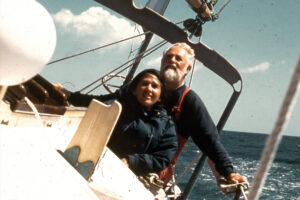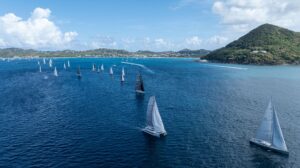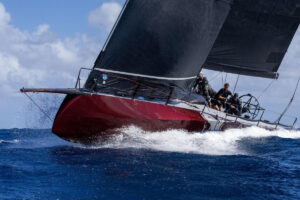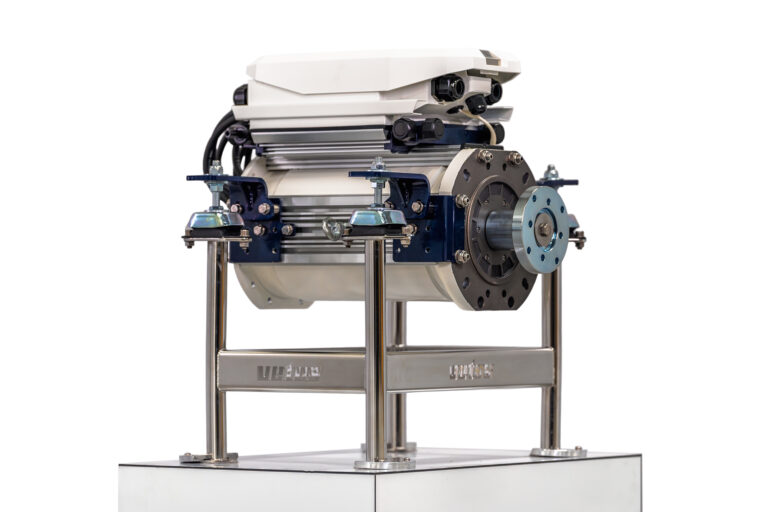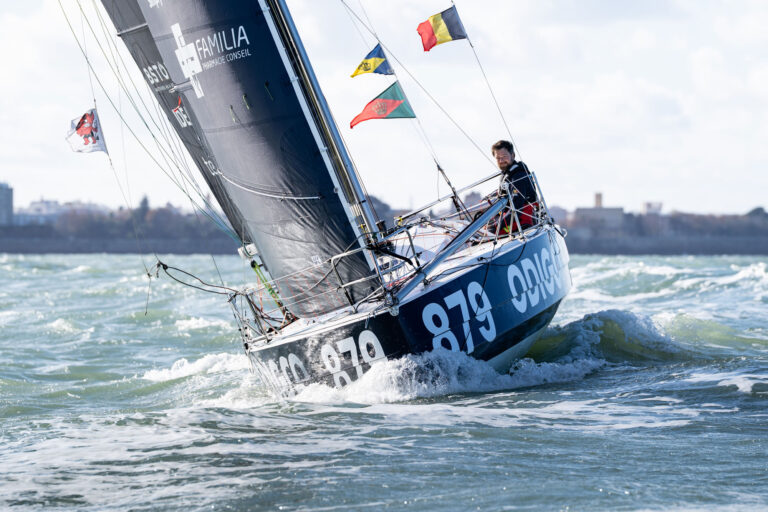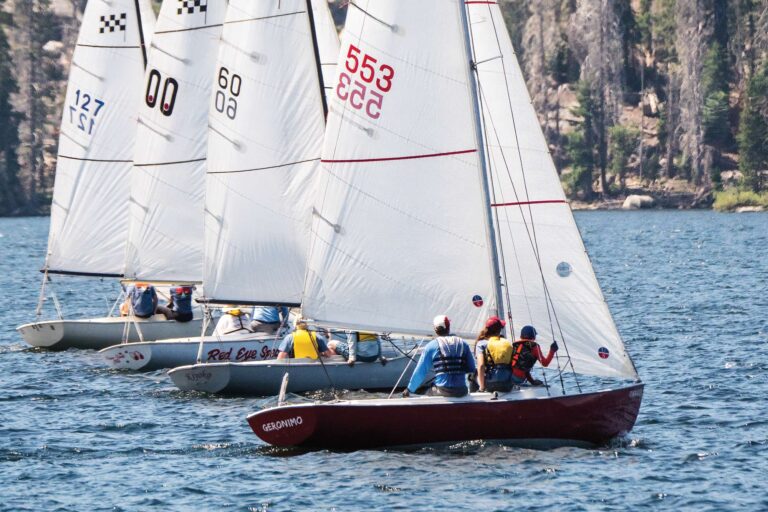
Do you see him?” I asked. “Nope. Only birds and rocks,” Tyler replied, his eyes still glued to the backside of the binoculars. “Blast the horn again,” he said. Inhaling deeply, I blew on the orange safety horn as loudly as possible, as if I could will the missing sailor to appear from the nearly vertical guano-covered rocks before us. Despite my best efforts, Guo Chuan did not appear; the horn blast only further excited the brown boobies and storm petrels who looked down on our 46-foot racing sailboat with curiosity. Scouring the remote Northwest Hawaiian Islands in the Papahanaumokuakea Marine National Monument, our search was the final effort to find the missing Chinese racing sailor Guo Chuan, who had fallen overboard from his maxi-trimaran, Qingdao China, while attempting to establish a world sailing record between San Francisco and Shanghai. We had known since leaving Honolulu that the chances of finding him at all, let alone alive, were somewhere between slim and none. Against the odds, our crew clung to the hope that we would achieve the impossible and miraculously find him. Some 500 miles northwest of Kauai, we found ourselves in one of the most remote and thoroughly unlivable spots on earth: the Gardner Pinnacles. It was here that our search would come to its conclusion and we would begin our trip back home with a late-December weather window that looked anything but certain. Almost as far as you can possibly get from a continental landmass, we were completely exposed to the elements, with no safe harbor nearby. Winter storm systems brewed above while multiple swells impacted the sea state. If we were lucky, we’d be back in port by Christmas morning. If we were unlucky, we’d sail in light air before bashing upwind into the winter trades.
When Chuan sailed underneath San Francisco’s iconic Golden Gate Bridge on October 18, 2016, he began a roughly 7,000-nautical-mile journey to Shanghai. Qingdao China was a 97-foot-long French racing trimaran, and Chuan hoped to make the solo crossing in about 18 days. The record was held by Italian sailor Giovanni Soldini and a full crew aboard a souped-up version of a 70-foot monohull from the Volvo Ocean Race; their voyage had lasted 21 days. As a Chinese “peace champion,” Chuan sailed to promote peace and sport while carrying a message of Sino-American friendship. The first great pioneer in Chinese offshore yacht racing, Chuan had already established multiple world records, but this would be arguably his most challenging endeavor yet. This was Chuan’s first solo record attempt since acquiring Qingdao China, formerly known as IDEC — at the time, the fastest sailboat to ever circumnavigate the globe with just one sailor aboard. The big red trimaran was designed by Nigel Irens and Benoit Cabaret, and built in France for famed French racing sailor Francis Joyon. Conceived for the specific purpose of breaking solo sailing records, Qingdao China was capable of eating up ocean miles at a rate of more than 30 per hour. Monstrous in size and no less significant in terms of technicality, the boat was a marvel of modern sailing technology that could reward her skipper with record-breaking daily runs when sailed properly, or capsize catastrophically when not.

After departing San Francisco on a beautiful fall day in mid-October, Chuan endured a long and grueling day full of sail changes before reaching more consistent northerly pressure and sailing off in the direction of the Hawaiian Islands. Beginning to pour on the miles, Chuan was making good speed while learning his boat in solo configuration. Less than a week out, he was passing north of the Hawaiian Islands with nothing but open ocean and consistent, manageable trade winds in his immediate future. Chuan was sailing across the Pacific toward his home country in his brilliant red maxi-trimaran at high speed, the first-ever Chinese sailor to enter the very French world of chasing solo-sailing records. Life was good.

Sometime around 0300 Hawaii time on October 25, Chuan’s team in China lost contact with the intrepid racer, with his boat’s position northwest of the Hawaiian Islands. After a half day of radio silence, the U.S. Coast Guard in Kalaeloa, Oahu, launched an HC-130 airplane to conduct a search. With a GPS tracker on board the boat, the Coast Guard was able to fly right to Qingdao China’s position, where they found the large red trimaran sailing under a single-reefed mainsail. A large gennaker was dragging in the water off the starboard side of the boat, and there was no sailor on deck.
Despite the Coast Guard’s best efforts, nobody emerged from the boat’s cabin. Two days later, crew from the 844-foot Navy assault ship USS Makin Island arrived on the scene and boarded Qingdao China to conduct a search, which confirmed that Chuan was missing. Lowering the mainsail and gathering Chuan’s personal effects, the crew issued a notice to mariners of the navigational hazard and departed the scene, while a larger search-and-rescue operation was conducted over the surrounding waters.
While it’s impossible to know exactly what happened that night, I think it’s safe to say that a struggle took place. Any sailor who’s ever had a large flying sail such as a spinnaker or gennaker go overboard knows of the incredible loads created by such a large sail dragging in the water. For one man by himself, the challenge of retrieving it would have been nearly insurmountable. It’s not my place to speculate as to exactly what went down that night, but the result was that Chuan went missing from his racing boat while trying to establish a solo-sailing record that would end in China. The brilliant engineer, professional sailor, world-record setter, champion of peace and sport, husband, father, true pioneer and adventurer was gone.
For the development of sailing in China — the world’s largest market — the tragedy of Chuan’s disappearance was tantamount to that of American Mike Plant going missing from his 60-foot Coyote while sailing to the start of his second Vendée Globe race. No American has achieved true corporate sponsorship for a similar effort in the 20 years since, despite the explosion of the sport in Europe and around the world. A testament to how much Chuan’s disappearance was a shock to the Chinese sailing community, multiple private search-and-rescue operations were launched, in addition to a major search conducted by U.S. Navy and Coast Guard assets.

I was one of five crew on the final mission. In an effort to bring closure to all involved and to settle a pending legal matter back in China, our plan was to set off from Honolulu, Oahu, to perform a visual search of three different islands in the Northwestern Hawaiian Islands chain to confirm that Chuan had not washed up on shore and was living somewhere, waiting for rescue. We would pick up and drop off a Fish and Wildlife Service representative on Kauai. With a total length of about 1,200 nautical miles, the expedition was to take place in late December and visit coral atolls and midocean rocks that volatile weather and swells render practically off-limits to scientists in winter. Our skipper, a local Hawaiian sailor named Roscoe Fowler, inspired confidence from the outset. This voyage and the boat were both a bit slapped together; had Roscoe had second thoughts, I would have likely bailed out as well. He’s the kind of guy you want in your group when the world ends — ultraresourceful and with a knack for harvesting food wherever he goes. When he said, “She’s a good boat, we’ll be all right,” that was all the convincing I needed; I was in. Rounding out our crew was a well-known Maui sailor and fisherman known only as Killer, Roscoe’s friend Tyler, and Mike from the Fish and Wildlife Service.

When Tom Wylie designed the 46-foot racing yacht Stardust, our boat for the expedition, search-and-rescue operations likely weren’t high on the design brief. With a 10-foot dinghy tied down on the bow, fuel cans lashed to the rail, soft water bladders on the cabin sole, and two large coolers full of dry ice and provisions, this was truly a “run what ya brung” effort at expedition yachting. The solid and storied yacht had sailed in both the Sydney-to-Hobart and Fastnet races, and we had a good crew with a can-do spirit. We had a mission in front of us and were up to the challenge.
After a picture-perfect light-air sail from Oahu’s Ala Wai Harbor to Nawiliwili Bay on Kauai, we were delayed for two days to let a winter weather system pass. As the westerly headwinds in the southern quadrants of the low began to back off from their peak, we set off toward the northwest on the afternoon of December 17. We had timed our departure perfectly. After several hours of motorsailing upwind, we found ourselves in a building northerly, which would strengthen and back to the northeast, setting us up for a quick broad reach down the islands.
Less than two days out of Kauai, the sacred Hawaiian island of Mokumanamana, also known as Necker Island, lay before us. Rising out of a deep blue sea whipped with white streaks, the island revealed its steep rocky cliffs and rugged shoreline formed by thousands of years of constant wave action. To make landfall here on any craft, let alone drift in the water with a life preserver on, would have been treacherous, to say the least. We were able to scan the entire shoreline with binoculars from a safe distance — a couple hundred meters out to sea — as we circumnavigated the small island. There was no sighting of Chuan, but we were able to clearly see many of the stacks of rocks that had been carefully placed along the spine of the island by native Hawaiians.

Allegedly used both in religious ceremonies and as a navigational aid dating back to the first-ever transpacific canoe voyages made by the Polynesians, the island surely holds many secrets; unfortunately, Chuan was not one of them. Located at about 23.5 degrees north, the island lies almost perfectly on the Tropic of Cancer, the northernmost boundary of the tropic regions on planet Earth. The importance given to the island’s location is a true testament of the navigational prowess and deep understanding of science and astrology of the native Hawaiians. According to local lore, it marked the border between the world of the living and the afterlife. It is also the line of demarcation between the oldest, sinking islands of Hawaii — to the northwest — and the eight main islands that succeeded the ancient islands and lie to the southeast.
Our Fish and Wildlife rep, Mike, recited an ancient Hawaiian prayer, E ho mai, while Tyler blew on a conch shell. In the prayer, we pledged our respect for the islands and prayed to the gods to bless us with wisdom and a safe passage within their islands as we crossed over to the dark side in the dead of winter. A couple hundred miles from civilization, we had reached our first waypoint with no sighting of Chuan. We carried on northwest to continue our search, feeling both a bit older and a bit wiser.

The crew posed for a picture before setting off from Kauai — from left to right: Tyler, Mike, Killer, Roscoe and Ronnie
The breeze stayed up, allowing us to quickly put Mokumanamana astern as we began closing in on French Frigate Shoals, a fringing coral-reef system with several islets that can be approached only from the southwest. We spotted our first land marker — La Perouse Pinnacle — at day break. We were immediately impressed by the vastness of the shoals, which stretch roughly 16 miles from northwest to southeast. French Frigate Shoals is home to the majority of the world’s monk seals (and accompanying Galapagos sharks), and is one of the most isolated and highly diverse marine ecosystems in the world. The shoals are full of nesting seabirds, while below the surface, French Frigate’s many still-pristine reefs are chock-full of fish.
Our original plan was to launch the dinghy and search a few of the islands without going ashore unless we found a body. That plan was quickly scrapped once we realized the enormity of the task at hand, the potential dangers in doing so and the uncertainty of our weather window. Had the search party in the dinghy had any problems whatsoever, they would be stranded at sea or, more likely, on a reef with a very long swim through some of the world’s sharkiest waters to get back to Stardust. In addition, the more time we spent at French Frigate Shoals, the higher the likelihood grew that we’d see 30 knots of breeze on the nose during the return trip. With crew safety and mission completion being the top priorities, we decided to motor along the leeward shores of the islands, as close as we could safely get with a 10-foot draft, while scanning the shore through binoculars.
Identifying seals, nesting albatross and massive bags of rubbish that were awaiting removal, we managed to thoroughly scan most of the low-lying landmasses through binoculars. Finally, we put eyes on the most promising location: Tern Island’s now-defunct airport runway and military base, complete with a small city’s worth of buildings. Several loud blasts on the air horn and a visual scan revealed nothing, so we made plans to continue the journey to our third and final waypoint, the Gardner Pinnacles.
“Just as the crew began to reach a breaking point from being wet, tired and covered in a thin sheen of diesel fuel, we received one of the best Christmas gifts that a sailor can hope for.”
By the time we rounded the Gardner Pinnacles, the wind had died to a whisper, and we turned Stardust around for the trip back toward Kauai. Having already done a fair amount of motoring, and with a lot of light air between our current position and the reinforced trade winds that we anticipated closer to Kauai, it began to look like we might run short on fuel. We would need to take advantage of any favorable wind that allowed us to make decent progress. As we entered the new breeze and began sailing upwind for the first time of the voyage, the new heel angle greatly exacerbated an issue we had been dealing with since shortly after leaving Kauai: a leaking diesel fuel tank. With a relatively small amount of fuel making its way into every individual bilge, nook and crevice of the boat, life on board became significantly less pleasant. The relatively flat days of downwind sailing in moderate trades were replaced by the type of wet, smelly environment that breeds constant frustration and erodes any semblance of patience. We were ready to be home. Just as the crew began to reach a breaking point from being wet, tired and covered in a thin sheen of diesel fuel, we received one of the best Christmas gifts that a sailor can hope for. The forecast for 30 knots of breeze, dead on the nose for 300 miles, simply vanished. The constantly changing and volatile weather patterns of the North Pacific in winter had worked in our favor. Instead of 30 from the east, the breeze built to just 15 knots from the north. We had a nice reach that climaxed with a maximum of 20 to 25 knots on the final afternoon, and Stardust knocked out the distance back to Kauai at a steady speed of 9 knots. Once out of the waters of the Papahanaumokuakea Marine National Monument — where fishing is prohibited for anyone but native Hawaiians — our hooks went back out and were met with immediate success. On our approach to Kauai, we caught a large wahoo and a healthy tuna.

Roscoe slowly guided the boat back up to the loading dock in Nawiliwili Bay, while two of us hopped off to secure the dock lines. He shut off the engine, presumably running on fumes by this point, while we all simultaneously cheered and shook hands. We hadn’t found Chuan, but we had survived a trip to the Northwest Hawaiian Islands in the dead of winter. We had sailed smart and fast, caught a few lucky breaks and also a couple of fish. It was 0300 on Christmas morning, and we were standing on dry land on the island of Kauai. Wasting no time, we broke out the last of our clean clothes and reveled in the fact that our world would no longer be covered in diesel fuel. While we began pulling gear off the boat, Roscoe went to work making poke bowls on the dock from the tuna we’d caught the previous afternoon. To be on the dock in Kauai on Christmas morning, eating fresh poke, was nothing short of a Christmas miracle.
Cold, wet, tired and away from our loved ones, a group that shoved off the dock as acquaintances just over a week earlier had arrived back to the same dock as family on Christmas morning. We had journeyed under sail to some of the most remote islands on Earth to look for a missing sailor. While we were unsuccessful in finding Chuan, we had found a part of ourselves in the process. Since losing his life in our island chain, while striving to promote peace and sport, Guo Chuan had become a son of Hawaii as well as his native land. His disappearance, the multiple rescue efforts launched from Hawaii, and his big red trimaran returning to Honolulu have now become a part of our history here in the islands; a history that began, somewhat ironically, when adventurous pioneers on multihulled sailing craft first sighted these islands. Goodbye, Guo; you may be gone, but you will never be forgotten. Aloha.
Ronnie Simpson is a sailor, surfer, and writer who lives in Honolulu and is currently pursuing a degree in integrated multimedia at Hawaii Pacific University. He cruises the Hawaiian Islands aboard his Peterson 34, Quiver. Ronnie is the co-founder of a wounded veterans sailing nonprofit coreveterans.org.

